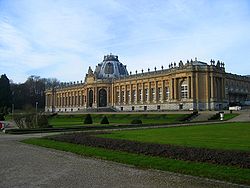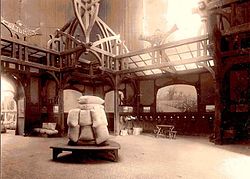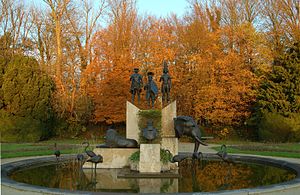- Royal Museum for Central Africa
-
Royal Museum for Central Africa 
Established 1898 Location Tervuren, Belgium Director Guido Gryseels Website Official museum site The Royal Museum for Central Africa (RMCA) is an ethnographical and natural history museum in Tervuren, just outside Brussels, Belgium. It was first built to show off King Leopold II's Congo Free State for the 1897 World Exhibition. It focuses mainly on Congo, Belgium's former colony. The sphere of influence however (especially regarding to biological research) extends to the whole Congo River basin, Middle Africa, East Africa and West Africa, but tries to integrate Africa as a whole. First purely intended as a colonial museum, after 1960 it became more focused on ethnography and anthropology. Like in most museums, there is a research department and a public exhibit department. Not all research is pertaining to Africa, for example the research on the archaeozoology of Sagalassos. Some researchers have strong ties with the Royal Belgian Institute of Natural Sciences.
The Museum will be completely renovated, work will begin in 2012. For this, the Museum will be closed from spring 2012 on.
Contents
History
After the Congo Free State was recognized by the Berlin Conference of 1884-1885, King Léopold II decided he had to show the potential of the country in an exhibition. Economic investors had to be attracted and the public had to know this faraway country better. After considering other places, the king decided to have the exhibition in his royal estate at Tervuren. When the 1897 International Exposition was held in Brussels, a colonial section was built in Tervuren with two new transport connections to Brussels city centre, the Avenue de Tervuren and the tramway line. The 44 tram line (Brussels-Tervuren) was built at the same time as the original museum by King Leopold II of Belgium to bring the visitors from the 1897 World Exhibition to the exhibition of the Congo in Tervuren. The colonial section was hosted in the Palace of the Colonies (although there was only the one colony). It was designed by the Belgian architect Albert-Philippe Aldophe. In the main hall Georges Hobé designed a distinctive wooden Art Nouveau structure to evoke the forest, using Bilinga wood, an African tree. The exhibition displayed ethnographic objects, stuffed animals and in the "Hall of the Great Cultures" Congo's most important export products were displayed: coffee, cacao and tobacco. In the park, a copy of an African village was built, in which 60 Africans lived. The exposition was a huge success.
In 1898 the Palace of the Colonies became the Musée du Congo, and now the exhibits became permanent. It was then that the scientific research really took off. But due to the avid collecting of the scientists, the collection soon grew too large for the museum and enlargement was needed. Léopold II saw it big: he wanted not only an Africa Museum but also Chinese and Japanese pavilions, a congress centre, a World School and so forth. Tervuren became a rich suburb of Brussels. The new museum started construction in 1904 by the French architect Charles Girault in neoclassical "palace" architecture, reminiscent of Petit Palais, with large gardens extending into the Tervuren Forest, a part of the Sonian Forest. It was officially opened by King Albert I in 1910 and named The Museum of the Belgian Congo. In 1952 the adjective "Royal" was added. In 1957, for Expo '58, a large building was constructed to receive African personnel: the Centre d'Accueil du Personnel Africain (CAPA). In 1960 the museum had its name changed to The Royal Museum for Central Africa.
At present, the RMCA is struggling with modernisation. Some call it "a museum of a museum", as it shows how a museum looked like in the mid-twentieth century. For example, Expo '58 still showed a harmonious Belgian-Congolese relationship, while the country stood on the brink of independence. A more modern exhibition "The Memory of Congo" (February 4, 2005 - October 9, 2005), tried to tell the whole truth of what happened in the Congo Free State before it became Belgium's colony, a very sensitive subject in Belgium. It was put on after The Guardian reported in July 2002 that, after initial outrage by Belgian historians over King Leopold's Ghost by Adam Hochschild, the state-funded museum would finance an investigation into Hochschild's allegations. The investigatory panel, headed by Professor Jean-Luc Vellut, reported its findings in 2004. The exhibit based on them was set up the following year.[1]
Critical of the museum was Adam Hochschild again, author of King Leopold's Ghost, who wrote an article for the New York Review of Books purporting to show 'distortions and evasions' in the special 2005 exhibition.[2]
Collections
- 10,000,000 animals
- 250,000 rock samples
- 120,000 ethnographic objects
- 20,000 maps
- 56,000 wood samples
- 8,000 musical instruments
- 350 archives, including some of Henry Morton Stanley's journals
The herbarium collection of the Congo Museum was transferred to that of the National Botanic Garden of Belgium in 1934.
Research
The scientific departments (together with the main collections) are housed in the Palace of the Colonies, the Stanley Pavilion and mainly in the CAPA building.
There are 4 departments:
- Department of Cultural Anthropology - Head: Jos Gansemans
- Ethnography
- Archaeology and Prehistory
- Linguistics and Ethnomusicology
- Ethnosociology and Ethnohistory
- Department of Geology and Mineralogy - Head: Johan Lavreau
- General Geology
- Mineralogy and Petrography
- Cartography and Photo interpretation
- Physical and Mineral chemistry
- Department of Zoology - Head: Michel Louette
- Vertebrates (Ornithology, Ichthyology, Herpetology, Osteology and Mammalogy)
- Entomology
- Invertebrates non-insects (Arachnology, Myriapodology, Acarology)
- Department of History and General Scientific Services - Head: Philippe Marechal
- History of the Colonial Period
- Contemporary History
- Agricultural and Forest economics (Geomorphology, Laboratory of Wood Biology)
Miscellany
- The collections in the basement of the CAPA building, of which a large part are fish, are so large that white arrows show the way to the exit. Large firedoors prevent an ethanol fire from spreading.
- The maceration room is only opened Friday night.
Gallery
See also
- Belgian Federal Science Policy Office (BELSPO)
References
- ^ Andrew Osborn Belgium exhumes its colonial demons The Guardian July 13, 2002
- ^ Adam Hochschild In the Heart of Darkness, New York Review of Books, 26 October 2005
External links
- Official museum site
- Collection etnomusicology
- Tervuren wiki page on the museum
- Mémoires des Rites Populations of Central Africa-in French but excellent pictures of ethnographic material from RMCA Tervuren.
- Flickr Images tagged RMCA
- Albertine Rift Project To access the many excellent pictures Pick a group (bird, butterfly fish) in top menu then go to the taxa list. Click on the species name if a photo is indicated by a camera pic on the right.
Coordinates: 50°49′51.20″N 4°31′6.59″E / 50.830889°N 4.5184972°ECategories:- Palaces in Belgium
- Museums in Belgium
- Natural history museums
- African art museums
Wikimedia Foundation. 2010.












